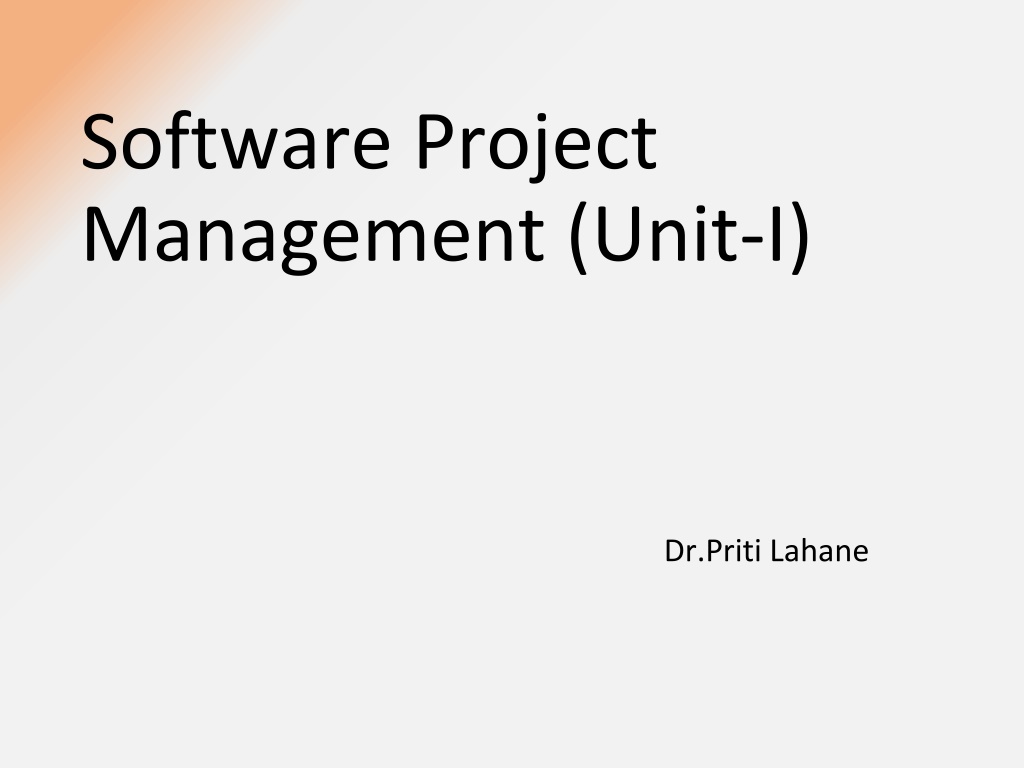
Introduction to Software Project Management Fundamentals
Explore the fundamentals of software project management, including the importance of SPM, project objectives, stakeholder management, and traditional vs. modern project management practices. Learn about the characteristics that distinguish projects and how SPM helps in planning, monitoring, and controlling activities for successful project outcomes.
Download Presentation

Please find below an Image/Link to download the presentation.
The content on the website is provided AS IS for your information and personal use only. It may not be sold, licensed, or shared on other websites without obtaining consent from the author. If you encounter any issues during the download, it is possible that the publisher has removed the file from their server.
You are allowed to download the files provided on this website for personal or commercial use, subject to the condition that they are used lawfully. All files are the property of their respective owners.
The content on the website is provided AS IS for your information and personal use only. It may not be sold, licensed, or shared on other websites without obtaining consent from the author.
E N D
Presentation Transcript
Software Project Management (Unit-I) Dr.Priti Lahane
Course Structure Syllabus
Unit 1 Introduction to Software Project Management (06 hrs.) Course Objective To discuss the fundamentals of Software Project Management Course Outcome Apply the practices and methods for successful Software Project Management Bloom s Level L3 : Apply
Introduction to Software Project Management (SPM): Why SPM is important What is a Project Contract Management Activities Covered by SPM Plans, Methods and Methodologies Some Ways of Categorizing Software Project
Stakeholders Setting Objectives Business Case Project Success and Failure What is Management? Management Control Traditional versus Modern Project Management Practices.
Introduction to Software Project Management Software Project Management is the discipline of defining and achieving targets while optimizing the use of resources such as time, money, people, materials, energy, space, over the course of a project Book Ref:Bob Hughes, Mike Cotterell and Rajib Mall: Software Project Management Fifth Edition, Tata McGraw Hill, New Delhi.
Why is Software Project Management Important? Planning Monitoring Control Planned Activity Group of People To carry out task What is a Project ? Contract Management Supervise Contract Deal with Technical Issues The feasibility study Planning Project Execution Activities Covered by SPM
The following characteristics distinguish projects: non-routine tasks are involved; planning is required; specific objectives are to be met or a specified product is to be created; the project has a predetermined time span; work is carried out for someone other than yourself; work involves several specialisms; people are formed into a temporary work group to carry out the task; work is carried out in several phases; the resources that are available for use on the project are constrained; the project is large or complex.
Plans, Methods and Methodologies A plan for an activity must be based on some idea of a method of work. A method relates to a type of activity. The output from one method might be the input to another. Groups of methods or techniques are often grouped into methodologies such as object- oriented design. Some Ways of Categorizing Software Project Compulsory versus voluntary users Information systems versus embedded systems Outsourced projects Objective-driven development Stakeholders Internal to the project team External to the project team but within the same organization External to both the project team and the organization
Project Success and Failure Setting Objectives Business Case Project Objective and Business Objectives Development Cost Sub-objectives and goals Agreed functionality Features of the System Required level of quality Measures of effectiveness On time Delivery Date Within budget.
Planning deciding what is to be done; Organizing making arrangements; Staffing selecting the right people for the job Directing giving instructions; What is Management Monitoring checking on progress; Controlling taking action to remedy hold-ups; Innovating coming up with new solutions; Representing liaising with clients, users, developer, suppliers and other stakeholders.
Management Control The Project Control Cycle
Planning Incremental Delivery Traditional versus Modern Project Management Practices Quality Management Change Management
Projects are non-routine and therefore more uncertain than normal undertakings. Software projects are like other projects but have some attributes difficulties. that present A key factor in project success is having clear objectives. Different different objectives. Conclusion stakeholders have For objectives to be effective there must be practical ways of testing that the objectives have been met. Where projects involve many different people, effective channels of information must be established.
